|
Related FAQs: Cooks Island Butterflyfishes, Hawaiian Butterflyfishes, Butterflyfish Identification, Butterflyfish
Foods/Feeding/Nutrition, Butterflyfish Compatibility, Butterflyfish Behavior, Butterflyfish Systems, Butterflyfish Selection, Butterflyfish Disease,
Over to other Regional
Accounts of Butterflyfishes: Hawai'i, Red
Sea, Maldives,
To:
A Fishwatcher's Guide to the Fishes of the Cook
Islands
Butterflyfishes
of the Cook Islands
|
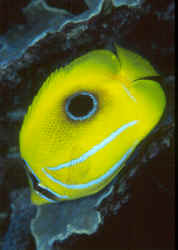
|
| Bob Fenner |
Chaetodon bennetti
|
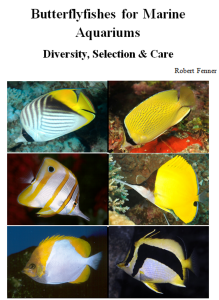 |
Butterflyfishes for Marine
Aquariums
Diversity, Selection & Care
New eBook on Amazon: Available
here
New Print Book on Create Space: Available
here
by Robert (Bob) Fenner |
Butterflyfishes, family
Chaetodontidae. There are two more species of Butterflies
found here than the Hawaiians, twenty-seven all told. They comprise the
usual blend of aquarium suitable to terrible survivability. I'll go
over them here accordingly, utilizing the sliding three level scale of
"good", ones that more than half live three months,
"medium" ones that only have live a month or so, and
"bad" ones where most all are dead within a month. I'll
leave out the "unknown" aquarium species here.
Good Cooks Butterflies:
Chaetodon auriga, the Threadfin. A great species throughout most of
its range.
| Chaetodon
auriga Forsskal 1775, the Threadfin Butterflyfish. A
great beauty and hardy aquarium specimen, though it will eat coral
polyps and anemones. See other materials on this species by
clicking on name. Widespread Indo-Pacific. An adult Auriga in the
Cooks |
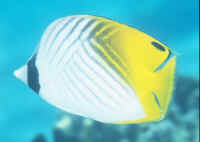
|
Chaetodon ephippium, the Saddleback Butterflyfish. To a large
size (9")
|
Chaetodon ephippium Cuvier
1831, the Saddleback Butterflyfish. To a large size (9") and
too often collected too large for aquarium use (get one 3-4"
best). Central and western Pacific. Very nice out of Hawai'i
for use in the U.S. Broad feeder on benthic invertebrates
including coral polyps. Here's one in the Cooks.
|
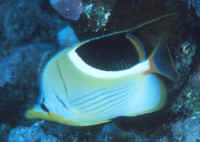
|
Chaetodon lunula, the Raccoon Butterflyfish. a very good
choice for eating pest Aiptasia anemones in reef tanks, though it will
consume coral polyps in some cases.
|
Chaetodon
lunula (Lacepede 1803), the Raccoon Butterflyfish.
Though not as attractive as its namesake in the Red Sea (C.
fasciatus), the Indo-Pacific Raccoon is just as hardy
images. This one in the Cook Islands, South Pacific.
|
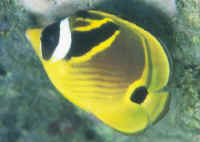
|
Chaetodon mertensii, the Chevron or Merten's
Butterflyfish. A common, but hardy and good-looking species.
|
Chaetodon mertensii Cuvier
1831, the Chevron or Merten's Butterflyfish. A common, but
hardy and good-looking species. You may find the Indian Ocean
variety of this species listed/sold as C.
madagaskariensis... it's the same species. Tropical
central Pacific to east African coast. To five inches long.
Pictured: one in the Maldives, Indian Ocean and one in the
Cooks, South Pacific.
|
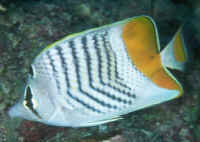 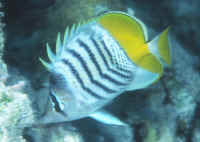 |
Chaetodon ulietensis, the Pacific Double Saddleback
Butterflyfish. A Pacific version of the Falcula or Saddleback
Butterflyfish (Chaetodon falcula) of the Indian Ocean.
|
Chaetodon ulietensis Cuvier 1831, the
Pacific Double Saddleback Butterflyfish. A Pacific version of the
Falcula or Saddleback Butterflyfish (Chaetodon falcula) of
the Indian Ocean. Omnivorous eating habits, chowing down on many
types of invertebrates and algae.. To about six inches in length.
Click on name for more.
|
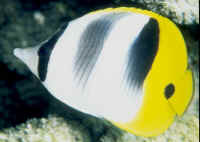
|
Medium Cooks Butterflies:
Chaetodon citrinellus, the Speckled Butterflyfish. A broad
feeder of invertebrates, including corals.
| Chaetodon
citrinellus Cuvier 1831, the Speckled Butterflyfish. Aggressive
in the wild, this is another broad feeder of invertebrates,
including corals. Widely distributed and common, though never
plentiful in the mid-Pacific all the way over to Africa. To five
inches overall. One in the Cooks |
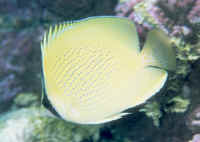
|
Chaetodon unimaculatus, the Teardrop Butterflyfish. Sometimes
good, other times too beat up to survive.
| Chaetodon unimaculatus
Bloch 1787, the Teardrop Butterflyfish. Often, too often imported
from Indonesia, the Philippines and even Hawai'i... like the
similar Indian Ocean species of the same common name this is an
"iffy" fish that mainly perishes due to the rigors of
human (mis)handling. Shown: a juvenile in the Cooks, an adult in
Hawai'i. |
 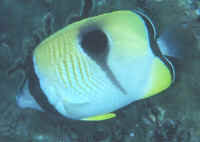
|
Bad Cooks Butterflies:
Chaetodon bennetti, Bennett's Butterflyfish. Most all
food consists of coral polyps
|
Chaetodon
bennetti Cuvier 1831, Bennett's Butterflyfish.
Central Pacific to Africa's east coast. To about six inches
total length. Most all food consists of coral polyps. Image made
in the Cook Islands.
|
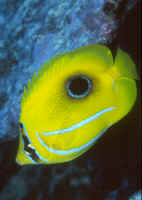
|
Chaetodon flavirostris, the Black or Yellow-Faced
Butterflyfish. Usually shy and non-feeding.
|
Chaetodon flavirostris
Gunther 1873, the Black or Yellow-Faced Butterflyfish. Usually
shy and non-feeding. Eats coral polyps, other bottom-dwelling
invertebrates and algae in the wild. To some eight inches long.
Way too often sold to the hobby as juveniles... they don't
live. The first one at a wholesalers, the second in the Cook
Islands.
|
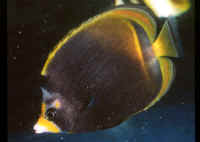 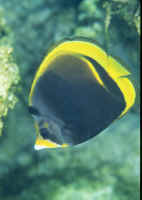
|
Chaetodon lineolatus, the Lined Butterflyfish. A foot long
beauty that eats corals, Anemones.
|
Chaetodon lineolatus Cuvier
1831, the Lined Butterflyfish. At a foot long, vying for largest
of the family. Widespread from Hawai'i over to the east coast
of Africa, into the Red Sea. A beauty that eats corals, anemones,
much of all else, but doesn't live. One in
Hawai'i.
|
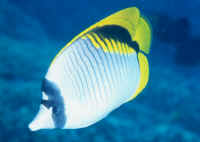
|
Chaetodon ornatissimus, the Ornate Butterflyfish. Yet another
obligate corallivore.
|
Chaetodon ornatissimus Cuvier 1831, the
Ornate Butterflyfish. Yet another obligate corallivore. Yes, a
beauty, but does not live in home fish tanks. Indo-west Pacific,
Including Hawaiian Islands. To about seven inches in length.
Commonly offered, doesn't live.
|
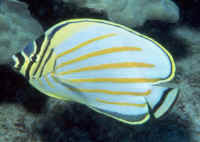
|
Chaetodon pelewensis, the Sunset or Dot-Dash Butterflyfish.
Very similar to the hardy Spot-Banded Butterflyfish, Chaetodon
punctatofasciatus.
| Chaetodon pelewensis
Kner 1868, the Sunset or Dot-Dash Butterflyfish. Very similar to
the hardy Spot-Banded Butterflyfish, Chaetodon
punctatofasciatus (see in "Good" Chaetodon section)
but with oblique body barring versus vertical. Southern Pacific
Ocean area. To five inches length overall. This one in the Cook
Islands. |
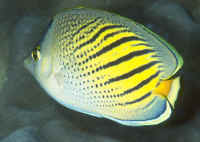
|
Chaetodon quadrimaculatus, the Four-Spot Butterflyfish. A few
specimens live and live, most die "mysteriously".
|
Chaetodon quadrimaculatus Gray 1831,
the Four-Spot Butterflyfish. Found in the central to western
Pacific, including Hawai'i. To six inches long. A few
specimens live and live, most die "mysteriously" in
aquarium conditions. In the wild, this species feeds principally
on Pocillopora coral polyps. Shown, a specimen in
the Cooks.
|
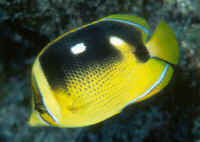
|
Chaetodon reticulatus, the Reticulated Butterflyfish. Dismal
survival records in captivity for this coral polyp eater.
|
Chaetodon reticulatus Cuvier 1831, the
Reticulated Butterflyfish. Nice looking, and "friendly"
underwater toward divers, but dismal survival records in
captivity for this coral polyp eater. Found commonly in central
and western Pacific. To six inches total length. One in the
Cooks.
|
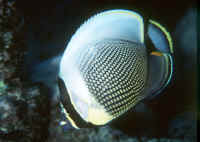
|
Chaetodon semeion, the Dotted Butterflyfish. A touchy species
that is occasionally imported into the West.
| Chaetodon semeion Bleeker 1855, the Dotted
Butterflyfish. A touchy species that is occasionally imported into
the West... found in the Indo-west Pacific from Sri Lanka to the
Tuamotus of French Polynesia. This adult in northern
Indonesia. |
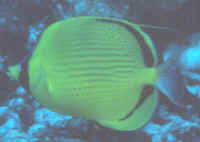
|
Chaetodon trifascialis, Chevroned Butterflyfish. This fish is
way too often offered in the trade.
|
Chaetodon
trifascialis Quoy & Gaimard 1824,
Chevroned Butterflyfish. This fish is way too often offered in
the trade, belying it's wide distribution, mid-Pacific to the
east coast of Africa and the Red Sea. Almost exclusively lives on
eating Acroporid polyps. To seven inches in length. This one in
the Red Sea.
|
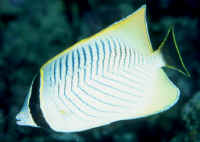
|
 |
Butterflyfishes for Marine
Aquariums
Diversity, Selection & Care
New eBook on Amazon: Available
here
New Print Book on Create Space: Available
here
by Robert (Bob) Fenner |

